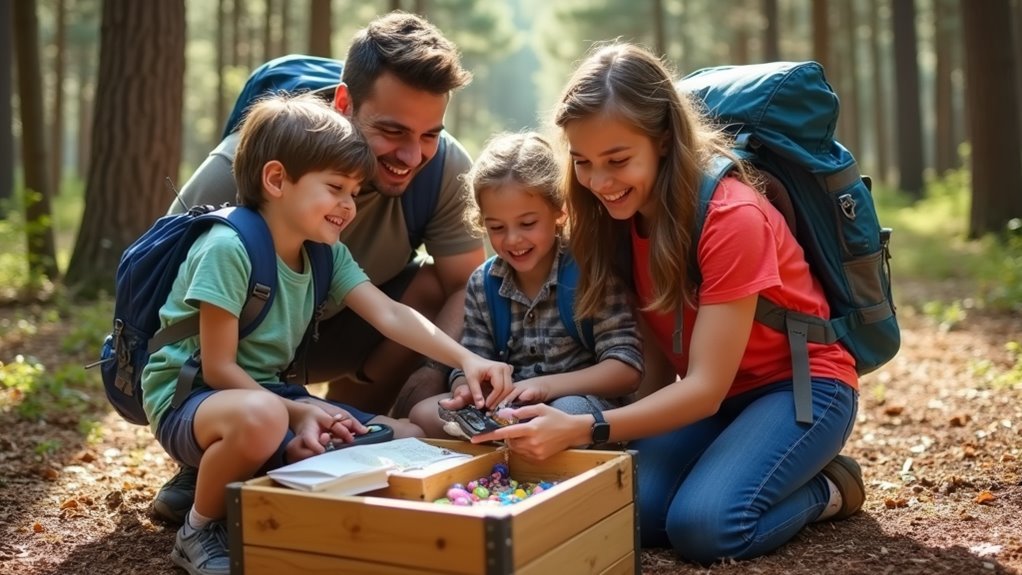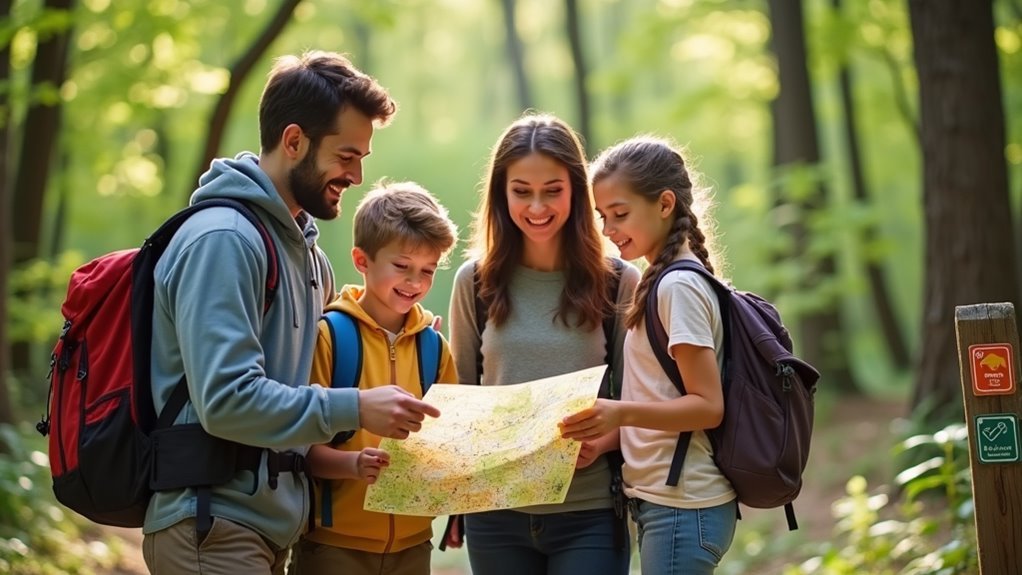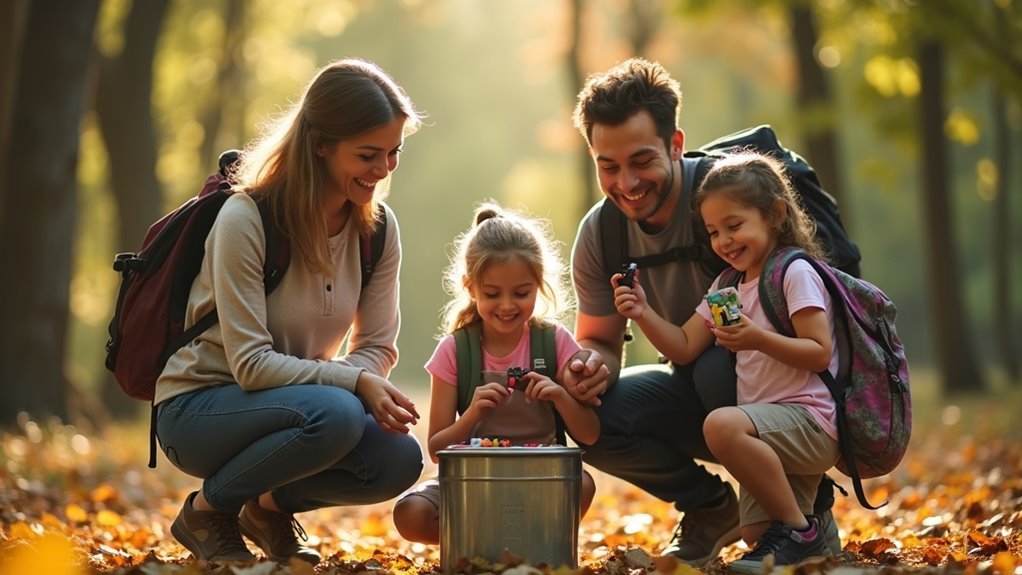Some of the links in this article may be affiliate links. If you make a purchase through these links, we may earn a small commission at no extra cost to you. Thank you.
I stumbled upon geocaching like finding a secret doorway in my own neighborhood. When I first took my kids on a geocaching adventure, I was pretty clueless about what we needed—app downloaded but no idea what those coordinates actually meant. I’ve since learned there’s a right way to introduce your family to this high-tech treasure hunt without ending up lost, frustrated, or dealing with disappointed kids. Want to know the difference between a successful family memory and a geocaching disaster?
Understanding Geocaching: The Modern Family Treasure Hunt

What’s better than spending quality time with your family while hunting for hidden treasures? I’ve found that geocaching is basically a tech-powered treasure hunt that’s perfect for creating memorable family adventures.
The concept is simple—you use GPS coordinates on your smartphone to locate hidden containers called caches in outdoor locations.
Since its start in 2000, it’s grown to include over 3 million active caches worldwide! I think what makes geocaching so special for family bonding is how it blends technology with real-world exploration.
Whether you’re searching in local parks or hiking trails, each hunt creates shared experiences as you work together to solve the puzzle. Trust me, there’s nothing quite like seeing your child’s face light up when they discover a hidden treasure!
Essential Gear and Preparation for Your First Geocaching Adventure
The five essentials you’ll need for your first geocaching adventure aren’t complicated, but trust me, they’ll make all the difference between a frustrating experience and an amazing family memory.
First, download the official Geocaching app on your GPS device or smartphone—it’s your treasure map!
Always carry your own pen (BYOP as we say) to sign the logbook when you find a cache.
For your first time, I’d recommend starting with easy caches (difficulty and terrain ratings below 1.5).
Don’t forget practical items like bug spray and sunscreen—nothing ruins a hunt faster than itchy mosquito bites!
And if you’re visiting larger caches, bring small trade items. My kids love exchanging little toys they’ve outgrown for something “new.”
Oh, and water! Always bring water.
Selecting the Perfect Family-Friendly Cache Location

Selecting the right geocaching location makes all the difference when you’re bringing kids along for the adventure.
When I started geocaching with my family, I quickly learned that local parks offer the perfect starting point for beginners.
I always look for traditional cache types with difficulty ratings below 1.5 in the geocaching app – these are free to access and won’t frustrate younger adventurers.
Stick with easy-rated traditional caches when geocaching with kids – they’re free and keep the adventure fun for everyone.
- Search for caches near your location that are in open, accessible areas with nearby parking
- Look for regular or small-sized caches, which often contain tradeable items kids will love
- Choose traditional cache types rather than puzzles for straightforward outdoor activities
- Check that the area is safe and appropriate – no steep terrain or busy roads
Trust me, nothing beats the excitement when your child yells, “I found a geocache!”
Navigating the Hunt: Using GPS Technology With Kids
Maneuvering through the digital wilderness with kids can actually be simpler than you might expect!
The official Geocaching app transforms using a GPS device into child’s play by showing GPS coordinates as green dots on a map.
I’ve found that kids love following the red line compass to navigate to a specific cache—it’s like a digital treasure map!
When geocaching with little ones, I recommend you search for caches near you rated 1.5 or below and start with a traditional type of cache.
As participants navigate, I try to explain basic latitude and longitude concepts—turning the hunt into a fun math lesson.
The best part? You don’t need fancy equipment to find the coordinates; just a smartphone and free account will get your family started!
Celebrating Success: What to Do When You Find Your First Cache

Finding your first geocache feels like winning a mini-adventure, doesn’t it?
The thrill of the hunt makes for an unforgettable family moment.
When you discover that hidden treasure, there’s a little protocol to follow that makes it official.
First, sign your name (your geocaching username) and date in the logbook—this proves you were actually there!
Then, if there are tradeable items inside, remember the golden rule: take something, leave something of equal or better value.
- Log your find on the app afterward—this builds your geocaching reputation
- Snap a family photo with your First Geocache—memories matter!
- Examine the contents together—kids love this part
- Take a moment to celebrate—sit down, rest, and share what excited everyone
Frequently Asked Questions
Do People Still Geocache in 2025?
Like embers rekindled by fresh air, Geocaching Revival is thriving in 2025. I’ve seen remarkable Global Surge with 7 million+ participants hunting 3 million+ caches worldwide, fueled by App Evolution and Tech Integration.
What Are the Three Main Rules of Geocaching?
As I’ve practiced geocaching etiquette, I’ve learned three core rules: sign the logbook (logbook requirements), trade fairly if taking items (trading guidelines), and rehide caches discreetly to maintain discretion ethics and environmental standards.
How to Do Geocaching With Kids?
Like breadcrumbs leading home, geocaching with kids creates lasting memories. I start with easy terrain selection, proper gear choices, and safety rules. Family planning includes kid activities, reward systems, and educational games that build excitement during our adventure preparation.
What Do C and D Mean in Geocaching?
In geocaching’s AbbreviationBasics, “D” means Difficulty (how hard to find the cache), rated 1-5. While “C” isn’t standard TermsBreakdown, it’s likely referring to Cache type or characteristics in GeocacheCodes I’ve encountered.